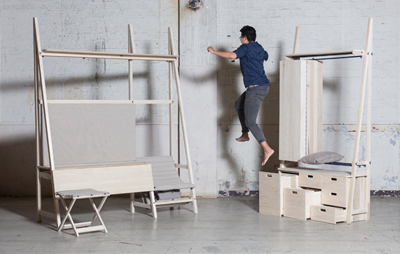|
Ambio light by Teresa van Dongen |
||
|
The projects that stood out at last week’s event in Eindhoven were those that presented workable solutions to problems as varied as prisoner rehabilitation, scarce living space, energy shortage and online sex crime Just as Philips was once the engine that powered Eindhoven, so is the city’s Design Academy today – creatively, at least. Aptly located in the former building of the technology giant, the school presented the usual slick display of graduate work during Dutch Design Week and acted as a starting point for many of the week’s visitors. This year’s event, Sense Nonsense, explored the relationship between sensible approaches to design and those that involve a less rational or magical “spark”. According to academy director Thomas Widdershoven, design is not “something to offer promise or hope”. Rather, “it is about experimenting with ideas and techniques”. But, while experimentation was clearly crucial for all the graduates, projects with more meaningful or lasting effects on society were also present. One of these was The White Building by Laura Ferriere and Éléonore Delisse, which offers a seed of hope for the successful rehabilitation of prisoners. Developed as a pilot project with the Penitentiary Institute of Veenhuizen, the concept is a transition space for prisoners to gain work experience at the end of their sentence. “The White house differs from what currently exists for prisoners,” Delisse says. “Here, the inmates are the first actors of their reinsertion: they take responsibility.” The White Building by Laura Ferriere and Éléonore Delisse In previous years, there have been projects that presented great opportunities for social transformation but these promises remained unfulfilled – for example, Mine Kafon (2011), a giant minesweeper to uncover unmarked landmines, which raised awareness, but ultimately did not function. The object, later purchased by MoMA, was criticised for being more of a visual statement than an answer to a problem. But rather than creating an aesthetic exhibition piece, Ferrier and Delisse have focused on results. The presence of a viable collaborator and consultant such as the Veenhuizen Institute gives their ideas credibility while the implementation of a pilot scheme lends the project weight. Joey Dogge presented a more commercial – and aesthetic – solution to a social problem that affects many in the Netherlands and other highly-populated areas: tiny living space. Dogge’s Yatno is a collection of flexible, space-saving furniture. “5m² is the minimum amount of space you can rent in the Netherlands,” Dogge says. “Nowadays, due to urbanisation, spaces are becoming even smaller. Space-saving furniture does exist, but they are usually expensive, immoveable modules created with specific rooms in mind.”
Yatno by Joey Dogge
The Ambio light by Teresa van Dongen takes a more environmental approach by harnessing the energy of bioluminescent bacteria – most commonly found on the skin of octopi – that emit light in response to oxygen and movement. The fixture, which balances two weights and a glass half-filled with the bacteria, illustrates how nature can be a source of energy in the home. Ambio light by Teresa van Dongen Around the corner from the academy at the Kazerne, designers sought to influence the process of design. At the Keyshapes exhibition, Unfold presented Of Instruments and Archetypes, a collection of objects – including a calliper, measuring tape and protractor – that allow people to take measurements of physical objects that can be transferred real-time to an on-screen digital 3D model that it needs to fit.
Of Instruments and Archetypes by Unfold The project that scooped the week’s top accolade, the Dutch Design Award, was a particular socially conscious, albeit controversial, one. Amsterdam-based creative advertising agency Lemz won over the judges with a campaign that targets online child sex tourism. Sweetie – an avatar with the appearance of a 10-year-old girl – was created to dupe those using webcams to seek out victims. Before introducing Sweetie to the world in a cleverly orchestrated media campaign and handing over their research to police, Lemz said it had already unveiled 1,000 offenders in 71 countries in 10 weeks from a secret warehouse in Amsterdam.
Sweetie avatar by Lemz While the hype around Sweetie is not undeserved, the wider response to the campaign remains to be seen. In their notes, the DDA judges were careful to highlight that Sweetie “opens the debate” on the use of design in this way and raises questions about privacy and ethics. So far, the press has been positive, but less supportive reactions are beginning to surface. After the first criminal conviction resulted from the use of the avatar in Brisbane last week, the president of the Australian Council for Civil Liberties Terry O’Gorman questioned the morality of the method and said it came close to vigilantism. The jury was right in saying projects like Sweetie are central to opening up debate, but in that forum the deeper implications should be discussed and deciphered. Dutch Design Week took place in Eindhoven from 18-26 October 2014 |
Words Enya Moore |
|
|
||























